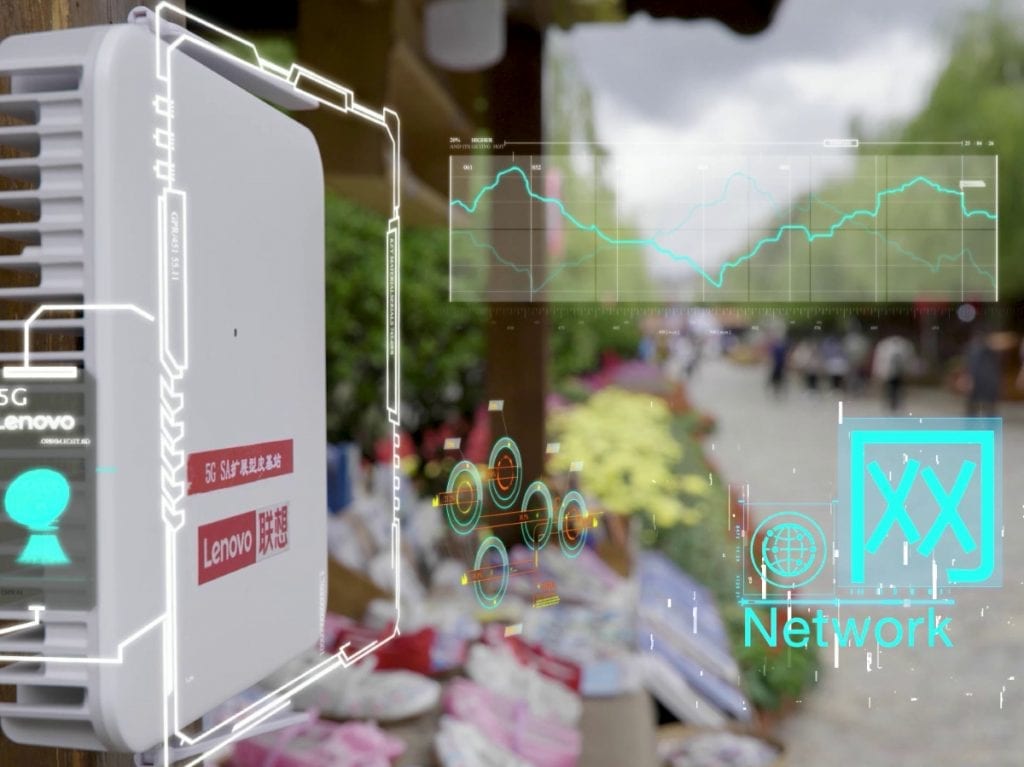In many ways, a walk around the Old Town of Lijiang, China, takes visitors back to the experience of what life was like here at its founding more than 1,000 years ago. Renowned as a UNESCO World Heritage Site, the Dayan Old Town’s orderly system of waterways and bridges established this trading town and still serves as an artery to keep progress flowing today.
But a powerful modern technology recently joined the ancient roots still growing in this city of more than 1 million people: 5G. These days you can spot cutting-edge operator-less sweepers and patrol vehicles in Lijiang. The technology powering these vehicles illustrates the partnership between Lenovo and Lijiang on 5G, part of the Lijiang Ancient Town 5G Application Demonstration Project.

As you can imagine, the intense flow of people puts a lot of pressure on managing this ancient town. Cleaning, patrolling, and providing dining services to the town’s annual tourists requires a lot of staffing and resources.
In 2019, Yunnan Province began vigorously to test 5G. In January 2020, Yunnan China Mobile opened the first 5G trial base station in Dayan, kicking off the new 5G era. Lenovo’s Converged Network Business Unit worked with Yunnan China Mobile to deploy a 5G network in Lijiang and worked with partners to develop 5G-enabled driverless vehicles, including sweepers, law enforcement, and patrol cars, under the Lijiang Ancient Town & Lenovo 5G Application Joint Research Base.
The Lenovo Lijiang project combines 5G with Lenovo-provided cloud, distributed storage, and AI and big data through network-based smart applications. 5G enables the capacity needed for the development of key IoT technologies to make facilities in parks smarter—the same zero latency and rapid data speeds powering solutions showcased at Lenovo Tech World 2020. The driverless vehicle, via the on-board 5G communication system, receives data while the on-board sound collection equipment and surround-view camera allow background operators to perceive real-time images and audio, almost as if they were physically present with the vehicle. It also allows HD video and images to be transmitted in real time to the cloud and to be shared among multiple vehicles, making coordinated scheduling possible.
Driverless road sweepers and patrol vehicles, operating on the 5G network, can recognize and avoid obstacles via on-board laser radar and inertial navigation systems. With the assistance of the surrounding ultrasonic radar, the auto-pilot system ensures safety during automatic driving.
“We focused on five major product categories, include Network Functions Virtualization Infrastructure, 5G Open Radio Access Network & Core network, Intelligent Service Aware System, 5G 2B Solutions, and Accelerator PCI-E cards, together with the Lenovo base stations, servers, storage, and networking products, and we built a full stack open 5G network solution,” said Wei Jianqiang, Vice President and General Manager of Lenovo’s Converged Network Business Unit (CNBU). “We are working with major telecom operators to optimize our 5G solutions to achieve technology leadership in this industry. We will also combine Lenovo’s long-term technological innovation and customer accumulation, striving to achieve successful practices in smart manufacturing, smart cities, smart transportation, and the 5G+ ecosystem.”
Additionally, Lenovo makes the ancient town a smart city with personnel entry and exit management, dynamic analysis of people flow, efficient passage, safety and control, and long-term and accurate data support to manage congestion in public spaces. By building standardized tiny 5G base stations and open source software and hardware equipment, Lenovo is helping reduce the commercial costs of 5G networks, which can be 68% greater than 4G network costs, and helping to quickly deploy near real-time 5G networks.
Future plans include each store having a tiny 5G base station similar to a router to ensure indoor 5G coverage. Enterprise-grade tiny 5G base stations will also provide 5G network coverage in office buildings, with larger coverage area. Lenovo’s portfolio on the wireless side covers micro base stations, extended base stations, and indoor and outdoor RRUs (Radio Remote Unit) to meet the needs of home and enterprise scenarios and help operators enhance coverage.
Established in 2018, Lenovo CNBU is committed to partnering with operators and enterprises in 5G Open Radio Access Network (O-RAN), Network Functions Virtualization (NFV), and edge cloud. Using Lenovo cloud network convergence technologies, CNBU can transform traditional closed and proprietary telecommunications equipment into an open architecture and achieve network telecommunications based on general servers, virtualized cloud platforms, and software to liberate operators from traditional closed solutions. This reduces operators’ costs in 5G construction and accelerates 5G deployment in China.
Lenovo remains a pioneer in the 5G space, from the world’s first foldable PC to infrastructure solutions in China’s ancient towns. As discussed during Tech World 2020, similar solutions coupled with AI-driven insights are creating new efficiencies and opportunities in retail, manufacturing, enterprise operations, and even 1,000-year-old tourist destinations.
